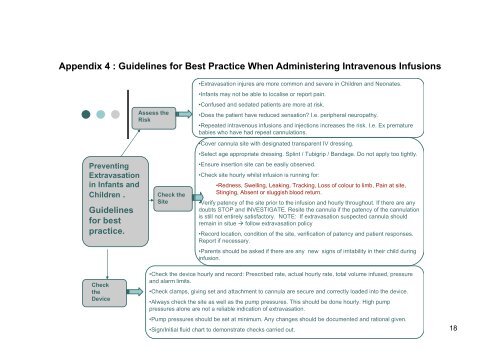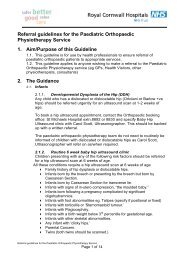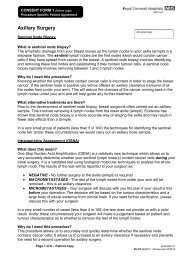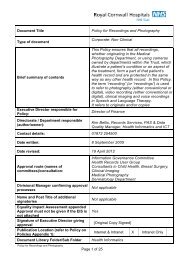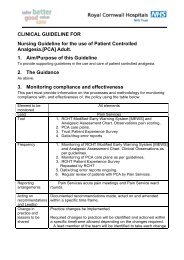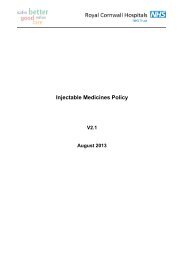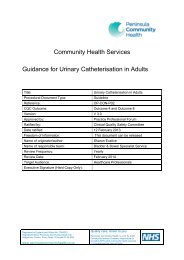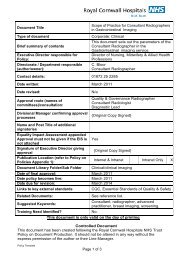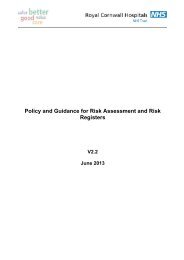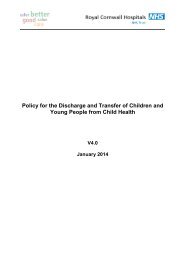Management of Extravasation of Cytotoxic Drugs in Children
Management of Extravasation of Cytotoxic Drugs in Children
Management of Extravasation of Cytotoxic Drugs in Children
Create successful ePaper yourself
Turn your PDF publications into a flip-book with our unique Google optimized e-Paper software.
Appendix 4 : Guidel<strong>in</strong>es for Best Practice When Adm<strong>in</strong>ister<strong>in</strong>g Intravenous Infusions<br />
Prevent<strong>in</strong>g<br />
<strong>Extravasation</strong><br />
<strong>in</strong> Infants and<br />
<strong>Children</strong> .<br />
Guidel<strong>in</strong>es<br />
for best<br />
practice.<br />
Assess the<br />
Risk<br />
Check the<br />
Site<br />
•<strong>Extravasation</strong> <strong>in</strong>jures are more common and severe <strong>in</strong> <strong>Children</strong> and Neonates.<br />
•Infants may not be able to localise or report pa<strong>in</strong>.<br />
•Confused and sedated patients are more at risk.<br />
•Does the patient have reduced sensation I.e. peripheral neuropathy.<br />
•Repeated <strong>in</strong>travenous <strong>in</strong>fusions and <strong>in</strong>jections <strong>in</strong>creases the risk. I.e. Ex premature<br />
babies who have had repeat cannulations.<br />
•Cover cannula site with designated transparent IV dress<strong>in</strong>g.<br />
•Select age appropriate dress<strong>in</strong>g. Spl<strong>in</strong>t / Tubigrip / Bandage. Do not apply too tightly.<br />
•Ensure <strong>in</strong>sertion site can be easily observed.<br />
•Check site hourly whilst <strong>in</strong>fusion is runn<strong>in</strong>g for:<br />
•Redness, Swell<strong>in</strong>g, Leak<strong>in</strong>g, Track<strong>in</strong>g, Loss <strong>of</strong> colour to limb, Pa<strong>in</strong> at site,<br />
St<strong>in</strong>g<strong>in</strong>g, Absent or sluggish blood return.<br />
•Verify patency <strong>of</strong> the site prior to the <strong>in</strong>fusion and hourly throughout. If there are any<br />
doubts STOP and INVESTIGATE. Resite the cannula if the patency <strong>of</strong> the cannulation<br />
is still not entirely satisfactory. NOTE: If extravasation suspected cannula should<br />
rema<strong>in</strong> <strong>in</strong> situe follow extravasation policy<br />
•Record location, condition <strong>of</strong> the site, verification <strong>of</strong> patency and patient responses.<br />
Report if necessary.<br />
•Parents should be asked if there are any new signs <strong>of</strong> irritability <strong>in</strong> their child dur<strong>in</strong>g<br />
<strong>in</strong>fusion.<br />
Check<br />
the<br />
Device<br />
•Check the device hourly and record: Prescribed rate, actual hourly rate, total volume <strong>in</strong>fused, pressure<br />
and alarm limits.<br />
•Check clamps, giv<strong>in</strong>g set and attachment to cannula are secure and correctly loaded <strong>in</strong>to the device.<br />
•Always check the site as well as the pump pressures. This should be done hourly. High pump<br />
pressures alone are not a reliable <strong>in</strong>dication <strong>of</strong> extravasation.<br />
<strong>Management</strong> <strong>of</strong> <strong>Extravasation</strong> <strong>of</strong> <strong>Cytotoxic</strong> <strong>Drugs</strong> <strong>in</strong> <strong>Children</strong><br />
Ratified: Review:<br />
•Pump pressures should be set at m<strong>in</strong>imum. Any changes should be documented and rational given.<br />
•Sign/Initial fluid chart to demonstrate checks carried out.<br />
18


